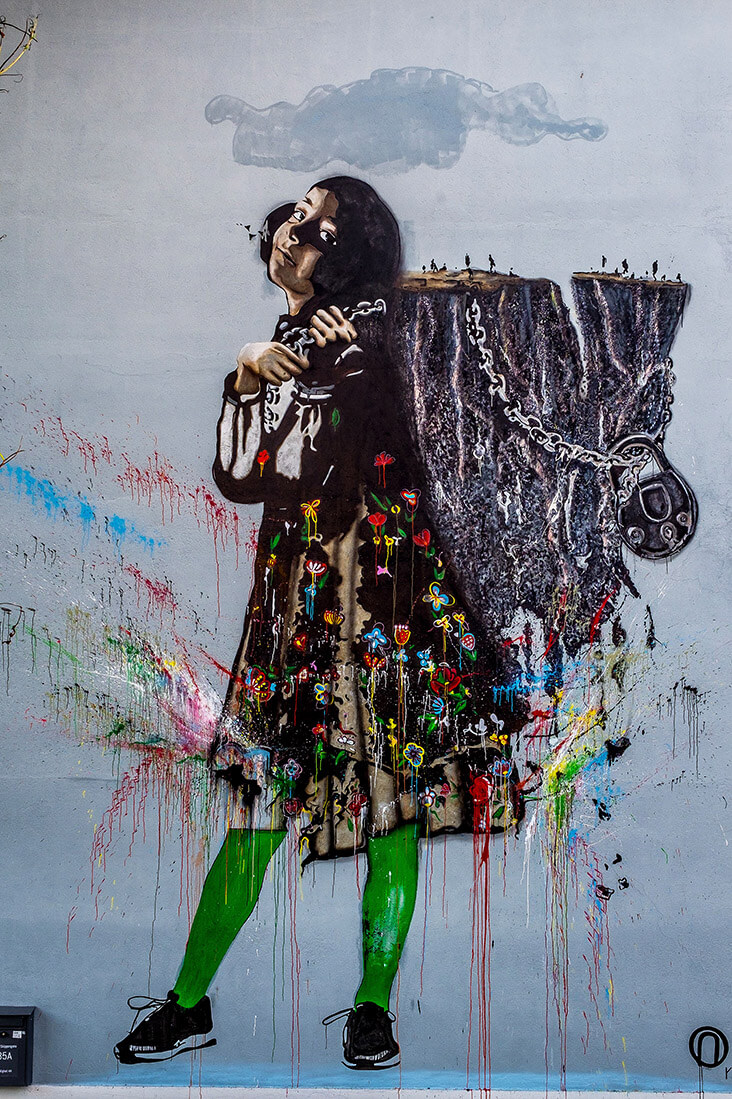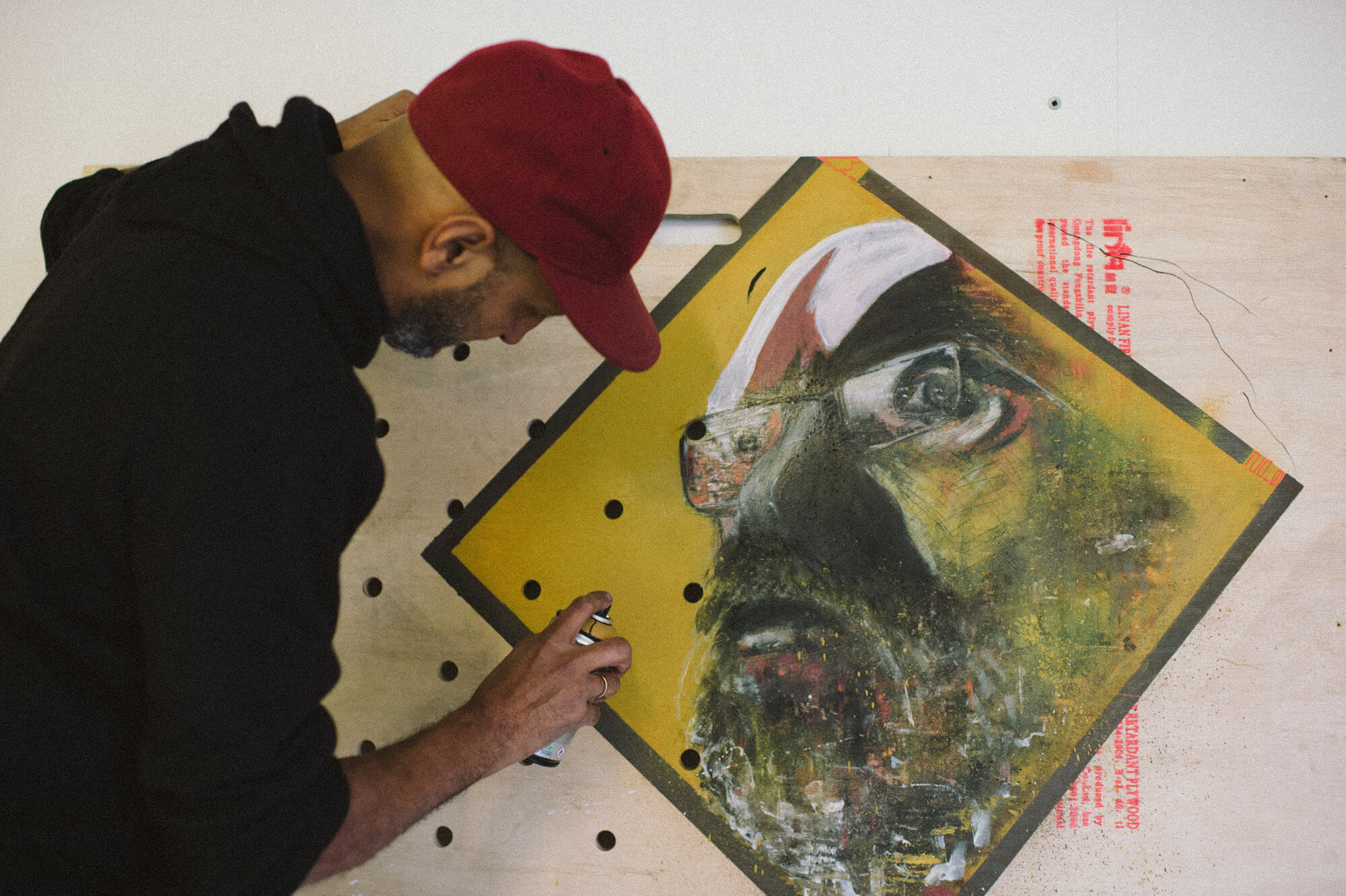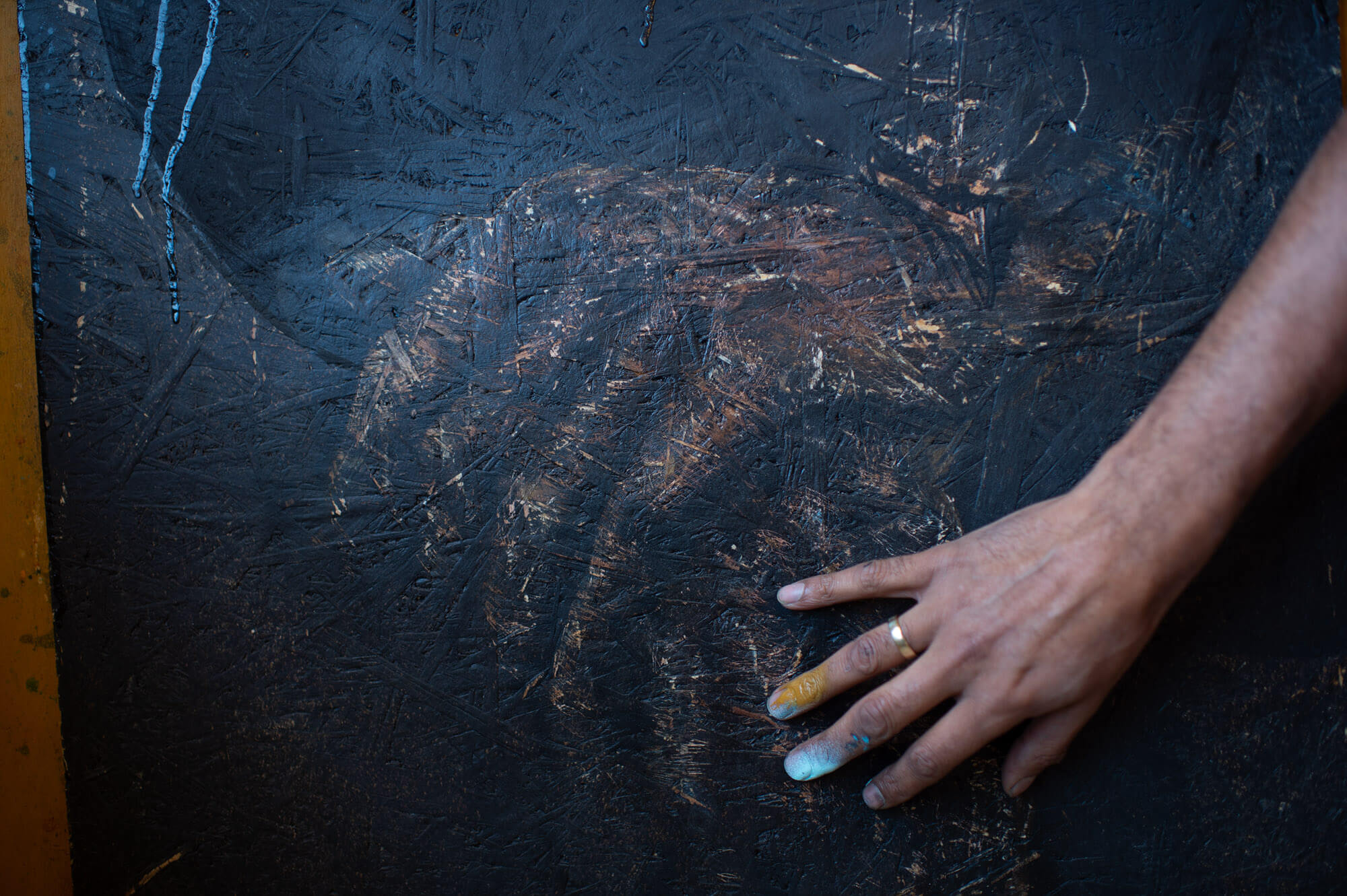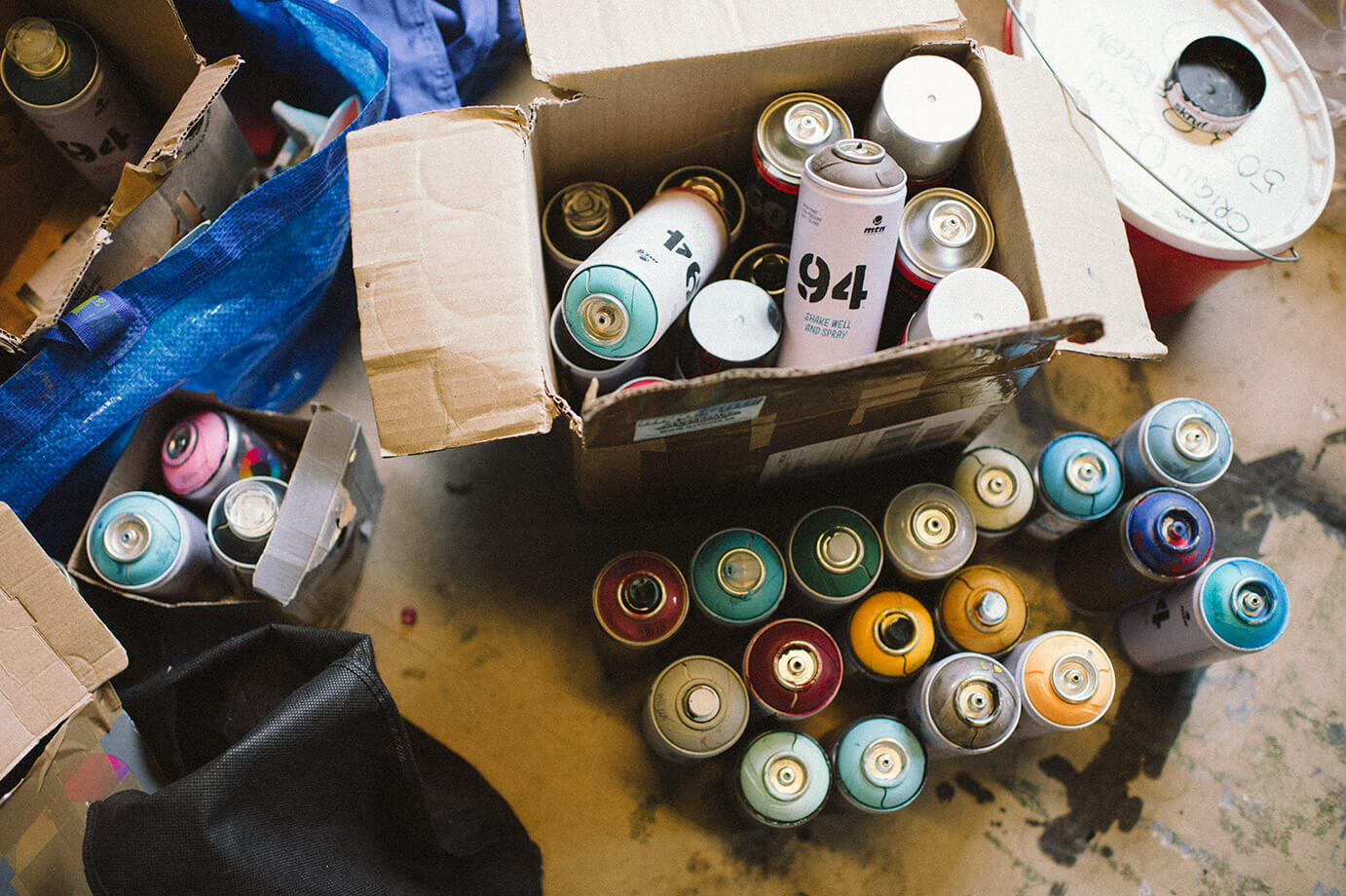Throwback to the 80’s, somewhere near North-East London: Thick letters written in a bubble style, which was the style at the time, are being formed by a young guy, on to a wall in a backyard. The luminescent green spray is running, while the letters are being printed onto the wall texture for an unsure future. The message says YOYO and is also the first signature, or tag, of an artist who has now entered the street-art-scene—this is where it began for Naeem Searle, but let’s get back to that later.
Graffiti art has always been glared at by people—undervalued, because if you do not look closely, a tag on a wall might just seem like some kid’s will to destroy; vandalism, that should be removed, covered up, and forgotten as soon as possible.
However, if you stop and take a second look, you might see something— try to imagine the scenery before the artist decided to make their mark on the public space. Picture the mark as a proof of something. This person might have had an important message, but no place to be heard or seen. It is easy to misunderstand what graffiti culture is about. Perhaps in 50 years, people will see that these marks are just observations of our society. Simple tags will be looked at in a different way. They will be appreciated for their calligraphic style, and respected because of their history and placement. These are facts clear as day, at least if you ask Naeem Searle today.

The things we need to talk about
A lot of water has run under many bridges since “YOYO”. Today Searle is making art under the name “NIMI” and lives in Bergen, where he now works full time as a street artist and supports the local graffiti scene. “For us street artists it’s a little bit funny” explains Searle: “We don’t need to compete with contemporary art—we are contemporary art.” People in the streets, outside your door, on the bus stop you pass every day, debate this question. These are conversations about our society and can be expressed in many different ways. Beautifully, confusingly, ugly… It does not matter as long as your voice is seen.
Searle naturally also sees the adversities in this business. “You have to make it yourself”, he says. “Nobody is going to support you”. There really is no stability in his daily work life and being a bit behind economically is a part of everyday life for him. But he’s not complaining. “My voice has never been this strong”.
The modern galleries get so much support every year, while street artists in positive outcomes receive a fourth of the budget they are applying for. Still, Searle believes that a lot of people visit these galleries, do so, just to stand there and understand nothing. He believes that in the end, some of these people might gain more by looking at a naive, honest drawing on the streets.
What some people may not understand, is that most street artists actually want our attention to make a positive change in the world. In their own way, they are telling us that we can not just sit back and watch anymore. People are starving, kids are suffering from mental illness, human rights are being taken away, right now, all over the world. “We need people to stand up now,” Searle says while releasing a fly through the window of his simple studio kitchen.
This is the place where he spends his rainy days—a studio space hidden in the center of Bergen. The rooms are filled with spray cans, while both finished and ongoing art projects are stashed here and there. For now he is busy organizing an auction that will take place in Bergen next month. Aesthetic Prosthetic aims to raise money for the only prosthetic workshop in Gaza, through collecting and auctioning street art. “The response has been fantastic so far,” explains Searle. Top artists from all over the world have contributed, and will be exhibited there, together with local artists. Searle himself will be auctioning away a portrait of Frank Aarebrot, painted on the surface of an old piece of wood.
It is easy to passively watch things happen on TV, but Searle says that it is actually easy to act as well. “It doesn’t take much to go out and make an impact on your local society,” he says. “Norway is such a safe environment, but there is poverty and hardship here too. It’s just that nobody wants to talk about it.”
Tagging, or painting your graffiti name on a wall, is a response stating that things aren’t great. According to Searle, taggers are as much a part of this group as any of the other artists, but, of course there must be rules too: “For example, everybody knows that you don’t tag on old wooden houses,” Searle says. “But that little piece of concrete under it though … If you respect your town, you put your response where it needs to be. “
Being a part of something
Searle was born in Hillbrow, Johannesburg, and brought up in a rough neighborhood in Harlow, England. Later he went on to settle down in Bergen, but it wasn’t always his plan. After moving around in Norway, first living in the East, he kept noticing a pattern; every time he would run into someone inspiring and full of life, they always told him that they came from Bergen. “I just thought: Fuck, I have to go to Bergen,” Searle laughs. Elsewhere, outside the bigger cities he often faced racism, and was therefore not ready to move to a small town.
For five years he struggled to make contacts and create a community for himself elsewhere in the country. It took him only five minutes to get things going in Bergen. By that time, Searle got his first job as a bouncer at the underground club Miles Ahead, while also working part-time in a furniture factory. He fit right in to the street- art-scene in Bergen. “They saw that I had something to bring to the table.”
Young poets on rooftops
Let’s revisit Harlow, where Searle discovered street art culture: growing up in the rough outskirts of town had a strong impact on his artistic development. “We really were the first wave of the hip-hop, breakdance, DJ-ing and graffiti-art generation,” he reminisces. Back then, in the years between 1983–1987, the youngsters bought spray-cans from the back of a garage. “Very old school, but I went back there much later, and the place still looks the same,” Searle laughs, before he continues: “We just wanted to try everything out, to be up on the rooftops of buildings.”
In Harlow’s Neo-Nazi-influenced society, you had to prove that you are somebody, if you wanted to get anywhere. It was all about problems in society, he says. Teenage life was not exactly carefree for these boys. It was often connected to drugs and violence. Hebron, also known as KANZ, was a good friend of Searle during that time: “He was such a talent, we were all shocked by his skill,”Searle says, while showing me a grainy photo of a young guy in a black hoodie, covering up a big wall with turquoise colored letters. “He just created poetry. You felt integrated with his work so easily.” Hebron took his own life when he was only seventeen years old. During his teens, Searle lost five of his closest friends.
“Positivist identity is still stuck in people’s heads here.”
Anonymous heroes
There are some secret street art groups in Bergen. People have the possibility to be freer in their expression, and to work on illegal things when they are protected by their street nam, but that lifestyle is not for Searle himself anymore. “I’m too old for that,” says the 48 years old artist. As artists we are all quite alone in our own heads. The street art community is a good way to stay connected. In the street-art-scene in Bergen, the artists age is from fifteen to sixty years old. “You would be surprised who you find there,” Searle says. Teachers, parents, grandparents … anybody with a message and desire to be heard is welcome. Everyone involved in the scene is very good at keeping their fellow artists protected. Somebody might see you when you are working on a piece on the street, but you can be sure that no one will reveal your identity: “It’s like Zorro and other old-time heroes. There might be a superhero under each T-shirt, and nobody wants to ruin their magic,” Searle says, smiling.



Think local
Expressions get old very fast in the graffiti scene, so you have to vary yourself as an artist, Searle explains: “Right now, Bergen is lacking a bit in variety. We need more sculp-ture, installations, paper paste ups, throw ups, and boards.
There are so many more expressions yet to be explored on the streets. The messages needs to be freshened up regularly. Positivist identity is still stuck in people’s heads here,” Searle says. ”Changing the narrative and pushing against the grain will not hurt this community, but will add a new depth to the work.” The government is a great target for graffiti artists, but Searle still encourages artists to think local. Foreign politics and Trump is too easy. What more is there to say?
Searle’s own passion right now is the identity around youth culture and their displacement. He is interested in how youths are communicating. Many artists use children in their pieces: “It is kind of like cats on the internet—a bittersweet medicine, you take it without thinking,” he says, laughing. He often depicts his young daughter in his works; like in the one in Stavanger, where she is carrying the Pulpit Rock on her back. The piece has deep meaning, but one interpretation is that it is a political statement to voice the feeling of not belonging to one’s home country.
Supporting, and looking forward
Searle likes to support small societies. For example, by running a workshop for kids who are home-schooled. Getting the kids out on the streets, seeing them create spectacular art for the first time is heartwarming: “children really contribute so much wisdom and joy,” he says.
Searle has a collection of success stories, which allow him to look back and be proud of the kids he has worked with. Working towards achieving the childrens´ dreams keeps him motivated: “You just want to promote them and show them to the world. What’s in their past is a big part of why they stand out, they just don’t know it themselves,” Searle explains further: “They have always seen themselves as a burden.”
Searle’s phone is ringing again; on it he quickly sums up some practical info about a painting in a friendly tone. He gives much of his time and effort to other artists, lifting them up in the community. He wants to get the tempo in Bergen up now, but it takes a bit of support to make that happen. Therefore he will spend the next year developing plans to make the graffiti community come together again.
These streets whisper messages and poetry for those who want to hear a language delivered to us in witty, colorful, sometimes grotesque, pieces. We can learn to read it and be a part of it, if we want to.
Maybe tomorrow will be the day when, for the first time, you notice the message someone has put out there for you on your local bus stop, and maybe in fifty years we will see what that message meant to our history.